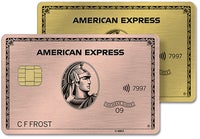Best credit cards for restaurants of April 2025
Advertiser Disclosure: Bankrate’s editorial team chooses and recommends the credit cards on this page. While we may receive compensation when users apply for cards through this page, our recommendations and card ratings are produced independently without influence by advertising partnerships with issuers.
Filter by
Showing 5 results
BEST FOR DINING + GROCERIES
Intro offer
Earn $200 Cash Back
Rewards rate
1% - 8%
Annual fee
$0
Regular APR
19.24% - 29.24% (Variable)
Why you'll like this: It's a low-maintenance card that earns well on dining and grocery purchases while charging no annual fee.
Limited time offer
Earn 100,000 intro bonus points
BEST FOR FOOD AND TRAVEL
Intro offer
Earn 100,000 intro bonus points
Rewards rate
1x - 5x
Annual fee
$95
Regular APR
19.99% - 28.24% Variable
Why you'll like this: The points you earn on dining and eligible delivery services are worth 25 percent more when you redeem for travel through Chase Travel SM.
BEST FOR DINING PERKS
on American Express's secure site
See Rates & Fees, Terms ApplyIntro offer
Earn 60,000 points
Rewards rate
1X - 4X
Annual fee
$325
APR
See Pay Over Time APR
Why you'll like this: This card includes many dining credits, which help offset the high annual fee, while earning high rewards on food delivery — a rare category.
Intro offer
60,000 bonus points
Rewards rate
1x - 10x
Annual fee
$550
Regular APR
20.24% - 28.74% Variable
Why you'll like this: This card earns exceptionally well on fine dining experiences through Chase Dining and offers solid bonus rates on other travel and dining purchases.
Intro offer
$200
Rewards rate
1% - 5%
Annual fee
$0
Regular APR
18.24% - 28.24% (Variable)
Why you'll like this: It's a great compromise between a flat-rate card and a category rewards card, perfect if you don’t want to overthink cash back.
Remove a card to add another to compare
Remove a card to add another to compare
Comparing the top credit cards for restaurants
| Card name | Best for | Card highlights | Bankrate score |
|---|---|---|---|
|
Dining + groceries |
|
5.0 / 5 Our writers, editors and industry experts score credit cards based on a variety of factors including card features, bonus offers and independent research. Credit card issuers have no say or influence on how we rate cards.
Apply now
on Capital One's secure site
|
|
|
Food + travel |
|
4.9 / 5 Our writers, editors and industry experts score credit cards based on a variety of factors including card features, bonus offers and independent research. Credit card issuers have no say or influence on how we rate cards.
Apply now
on Chase's secure site
|
|
|
Dining perks |
|
4.9 / 5 Our writers, editors and industry experts score credit cards based on a variety of factors including card features, bonus offers and independent research. Credit card issuers have no say or influence on how we rate cards.
Apply now
on American Express's secure site
See Rates & Fees
, Terms Apply
|
|
|
Fine dining |
|
5.0 / 5 Our writers, editors and industry experts score credit cards based on a variety of factors including card features, bonus offers and independent research. Credit card issuers have no say or influence on how we rate cards.
Apply now
on Chase's secure site
|
|
|
Automatic bonus cash back |
5% cash back on purchases in your top eligible spend category each billing cycle (can include restaurants), up to the first $500 spent, 1% cash back thereafter
1% cash back on all other purchases
No annual fee
|
|
Researching the best credit cards for restaurants
We thoroughly rate and research the best restaurant cards based on key criteria to help you make confident decisions when choosing your next credit card. Learn more about our methodology below.
How much could you earn with a credit card for restaurants?
Dining and takeout typically account for a large portion of everyday spending. According to the U.S. Bureau of Labor Statistics Consumer Expenditures Report, the average consumer spent $3,933 per year on food away from home in 2023. Based on this trend, consumers spend just under $330 per month on average at restaurants, on take-out or delivery. A spending amount this high makes the category a prime opportunity for earning plenty of credit card rewards.
The popular flat-rate and tiered bonus rewards cards below can give you a sense of how much you could earn from spending $3,900 annually on dining:
| Card name | Dining rewards rate and perks | Estimated rewards earned, plus perk value |
|---|---|---|
| Basic cash back card (example) | 1% cash back | $39 |
| Capital One Quicksilver Cash Rewards Credit Card | 1.5% cash back on all purchases | $58.50 |
| Chase Freedom Unlimited® | 3% cash back on dining purchases | $117 |
| Capital One Savor Cash Rewards Credit Card | 3% cash back on dining purchases | $117 |
| Citi Custom Cash Card | 5% cash back on dining purchases (if it’s your top spending category that billing cycle, up to the first $500) | $195 |
| American Express® Gold Card | Earn 4X Membership Rewards® points per dollar spent on purchases at restaurants worldwide, on up to $50,000 in purchases per calendar year, then 1X points for the rest of the year. | $156 (if you redeem points through Amex Travel) |
Here’s how one Bankrate expert uses his restaurant credit card
Bankrate writer Ryan Flanigan wants people to understand how a restaurant credit card can become a go-to card:
"Using a restaurant card for dining expenses is one of my favorite ways to generate points. I've always been a foodie, so I spend a lot in this category, whether it's takeout or dining out. I try to always use one of my go-to cards: the Chase Sapphire Reserve or Amex Gold. Both earn great rates on dining in their respective programs, so I use whichever card I'm trying to stockpile points with. I might also consider using a rotating-category card if one of its bonus categories is dining.
Basically, I want to get the biggest return possible whether I'm loading money onto a dining app or eating at a five-star restaurant.
Pro tip: if you can get people you dine with to give you cash or Venmo you for what they get, put the entire bill on your card and reap the rewards."
— Ryan Flanigan, Writer, Credit Cards
Expert advice for choosing a restaurant card
Restaurant credit cards are surprisingly versatile options for cash back and rewards. However, dining can be a broad category as far as what each issuer considers an eligible purchase and these cards sometimes have the most expensive fees and interest rates. Here are a few tips for finding the right card for you:
- Evaluate your spending: Compare your dining spending to all of your other spending combined. If it takes up a majority of your budget, a dining card is a great idea.
- Choose cash back or points: Specify the kind of places you eat and whether you’re on the go more often than you are at home. A travel card can help you leverage dining rewards into travel redemptions; a cash back card will be better for flexible rewards.
- Compare rates and fees: Some restaurant credit cards charge annual fees, foreign transaction fees and late payment fees. Forecast your annual cost and weigh the benefits and perks against the cost of each card you’re considering. If you find that a card has an annual fee, but also offers dining credits that would be useful to you, it may be worth it.
- Narrow your options: Make a short list of cards based on their cost and whether or not you can afford them. When you have two or three options you’re interested in, that’s when you can get specific about comparing the rewards and perks.
- Evaluate your spending: Compare your dining spending to all of your other spending combined. If it takes up a majority of your budget, a dining card is a great idea.
- Choose cash back or points: Specify the kind of places you eat and whether you’re on the go more often than you are at home. A travel card can help you leverage dining rewards into travel redemptions; a cash back card will be better for flexible rewards.
- Pair multiple bonus categories: It's a good idea to get a restaurant card with a great rewards rate for other spending categories in your budget. For instance, grocery and travel categories are common staples on some of the best dining cards.
What people are saying about the best credit cards for restaurants
Dining and restaurant rewards are always a popular topic among cardholders and many are happy to share their recommendations and insights online. On subreddits r/CreditCards and r/personalfinance, the Capital One Savor Cash Rewards Card, Citi Custom Cash, U.S. Bank Altitude Go and the American Express Gold Card are some of the more popular cards in conversation. Here's a look at the first-hand, user experiences for these top restaurant cards:
How to use your restaurant credit card
Once you have a restaurant credit card, you’ll want to use it to its full potential and rack up as much cash back or points as you can. Here are some expert tips to keep in mind as you dine in or take out with your card.
-
Limit the amount of fees you pay
Credit card fees and interest charges can easily negate any rewards you earn. If your card charges an annual fee, make sure you can earn enough rewards or use any available credits or monetary perks to offset it. If you’re struggling to offset what you pay in fees, consider switching to a more affordable card.
-
Check category restrictions
While dining bonus categories generally cover popular everyday merchants, such as fast food chains, it’s important to consider each card’s fine print. For example, the Chase Freedom Unlimited excludes bakeries in its dining bonus category, so this card may not be beneficial if you make daily trips to your neighborhood bakery.
-
Understand point valuations
Travel rewards cards like the Chase Sapphire Preferred or Amex Gold are better choices than cash back cards if you want to use your rewards to help fund future trips. On the other hand, a cash back card is better if you’ll mainly redeem rewards to offset your daily spending.
-
Use perks and benefits
Much of the value of restaurant credit cards is wrapped up in perks and benefits the issuer offers. The American Express Gold Card is a great example of a rewarding dining and travel card with a rich perks portfolio, but it’s expensive to hold. Although costly, the Amex Gold carries enough value from credits to offset its high annual fee.
Frequently asked questions about restaurant credit cards
How we assess the best restaurant rewards cards
When evaluating the best restaurant rewards cards, we consider a mix of factors, including how cards score in our proprietary card rating system and whether cards offer features that fit the priorities of a diverse group of cardholders, from earning rewards at restaurants to scoring a large sign-up bonus or high-value perks. Whenever possible, we also feature cards that are available at various credit levels and price points.
We analyzed over 150 of the most popular rewards cards and scored each based on its rewards rate, estimated annual earnings, welcome bonus value, APR, fees, perks and more to determine whether it belonged in this month’s roundup of the best restaurant rewards cards.
Here’s a quick look at the factors that make up our card scoring methodology for rewards and cash back cards (the card types most likely to earn rewards at restaurants).
Rewards & cash back card scoring factors
-
Value 65%
-
Flexibility 15%
-
Perks 15%
-
Customer experience 5%
For Capital One products listed on this page, some of the benefits may be provided by Visa® or Mastercard® and may vary by product. See the respective Guide to Benefits for details, as terms and exclusions apply.
*The information about the U.S. Bank Altitude® Go Visa Signature® Card and U.S. Bank Cash+® Visa Signature® Card has been collected independently by Bankrate.com. The card details have not been reviewed or approved by the card issuer.









